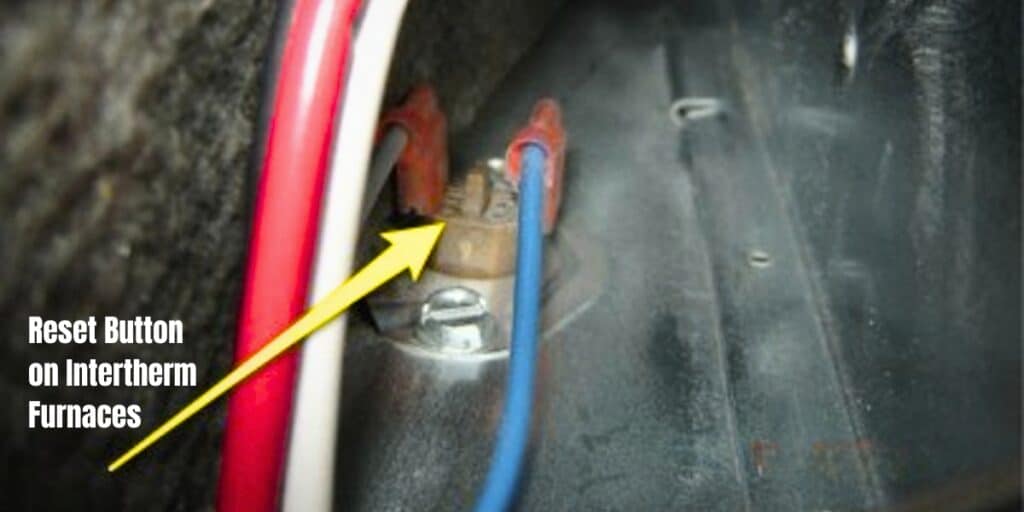During my tenure as an HVAC technician specializing in home heating solutions, I have frequently serviced Intertherm furnaces. A crucial yet occasionally overlooked element of these systems is the reset button. The Intertherm furnace reset button acts as a protective mechanism, powering down the furnace in response to any faults, thereby averting potential hazards or damage.
When an Intertherm furnace shuts down unexpectedly, possibly due to overheating, a failed flame, or other malfunctions, resetting it is critical. This reset function serves as an immediate fix for minor issues and as a diagnostic measure, potentially obviating the need for urgent professional repair.
Knowing how to locate and use this button is crucial for addressing immediate issues and maintaining your furnace’s performance and safety over time. By understanding the reset procedure for Intertherm furnaces, homeowners can ensure a continuous supply of heat and peace of mind.
What is a Furnace Reset Button?
The Intertherm furnace reset button is the furnace’s built-in circuit breaker or emergency stop.
Its main function is to disrupt the power before any potential hazards escalate, much like a trip switch. When the furnace’s internal monitoring system detects unsafe conditions or could damage internal components, such as overheating, lack of ignition, or a failure to detect a flame, it triggers an automatic shutdown.
This is where the reset button comes into play; it’s the bridge that allows you to safely attempt to restart your furnace after addressing the issue that caused the shutdown.
This small but crucial button acts as a first line of defense, not just for the furnace but for the safety of your home. Without it, furnaces could continue to operate under dangerous conditions, posing a risk to the household. When pressed, the reset button will clear the shutdown error and attempt to restart the furnace.
If the underlying issue is resolved, the furnace will operate normally again. If not, the furnace will likely trigger the reset once more as a precaution.
How do you locate the Intertherm furnace reset button?
Locating the Intertherm furnace reset button is quite straightforward once you know where to look. Safety is paramount, so ensure your furnace is off before you begin. You’ll typically find the reset button inside the furnace, but you must access the interior first.

Start by removing the front panel—this is usually a simple task that involves lifting the panel upwards and pulling it out or unscrewing a few fasteners. With the panel removed, look towards the burner compartment. This is often situated at the bottom of the furnace. The furnace reset button is designed to stand out, with a bright red or yellow color for easy identification.
It should be prominently placed, often near the burner or close to the control panel.
Remember, the reset button is not a cure-all; it’s a means to restart your furnace after a fault has occurred and you have taken corrective measures. It’s always recommended to seek a thorough inspection from a professional if the reset button trips frequently, indicating a persistent problem that requires expert attention.
When to Use the Reset Button
The reset button is typically employed when the furnace has ceased operation due to a non-critical fault. This could be because of a temporary glitch, a power surge, or a minor mechanical hiccup. It’s essential, however, to first rule out any immediate danger.
If you notice any smells indicative of a gas leak, see smoke or signs of a fire, or detect any unusual noises coming from the furnace, it’s crucial to avoid the reset button and instead disconnect the power supply and contact emergency services or a professional technician.
Another time to consider using the reset button is after addressing a known issue that caused the furnace to stop. For example, if the filter was extremely dirty and has been replaced or if the furnace was overloaded and had some time to cool down.
How to Reset Intertherm Furnace
Resetting the Intertherm furnace should be done with caution and an understanding of what it does. After you’ve ensured there are no safety risks and decided that pressing the reset button is the appropriate action, here’s what to do:
- Locate the reset button, as described previously, inside the burner compartment after removing the access panel.
- Press the button firmly and release it. It should be a deliberate press, not too quick, to ensure the system registers the action.
- Listen for a click or watch for a signal, such as a flashing light, which confirms that the button has been engaged.
- Once pressed, the furnace will attempt to restart. This process may involve the ignition of the burners and the beginning of a heating cycle.
It’s important to have patience; the Intertherm furnace may take a few moments to resume operation as it goes through its safety checks and startup sequence. If the furnace does not start up after the initial press, it’s advisable to wait at least 30 minutes before trying again. This waiting period is necessary to prevent an excess buildup of fuel in the furnace, which could be hazardous.
Repeatedly pressing the Intertherm reset button without allowing this pause can lead to various problems, including flooding the combustion chamber with unburned fuel, which can create a dangerous situation the next time the furnace starts.
If the furnace still fails to start after a second attempt, or if it requires frequent resets, it’s a clear sign that a deeper issue needs to be addressed by a professional technician. Regularly relying on the reset button is not a sustainable or safe way to manage your furnace’s operation.
Troubleshooting After Reset
If the furnace shuts off again shortly after resetting, it’s sending a clear message that something isn’t right. As an experienced HVAC technician, let me guide you through what to check before concluding that professional help is needed.
Immediate Steps After a Reset:
- Check the Filter: A clogged air filter can cause your furnace to overheat and shut down. If you find the filter dirty, replace it with a new one and try operating the furnace again.
- Inspect the Thermostat: Sometimes, the issue might be with the thermostat settings or its batteries. Ensure it’s set to ‘heat’ and the setting is high enough to call for heat. Replace the batteries if needed.
- Look for Obvious Signs of Trouble: This includes checking for blockages in the vents, signs of wear on the belts and pulleys, and ensuring the furnace door is properly closed.
If the Furnace Still Doesn’t Maintain Operation:
- Ignition System: The problem might be with the ignition system. Modern furnaces have electronic ignitions that can fail and prevent the furnace from starting. This is a complex component that typically requires a professional’s attention.
- Fuel Supply: For gas furnaces, ensure the gas valve is open and there’s a gas supply. If you suspect a problem with the gas supply, this is definitely a time to call a technician.
- Flame Sensor: As a safety precaution, a dirty or faulty flame sensor can cause the furnace to shut down. Cleaning the sensor can sometimes resolve this issue. Still, if it’s defective, it will need to be replaced by a professional.
- Overheating: If the furnace has overheated, it may take a while to cool down before it will start again. Overheating can be caused by a lack of airflow due to a dirty filter, blocked air ducts, or a failing blower motor.
- Control Board: A malfunctioning control board can lead to various issues, including a failure to start. This is a sophisticated piece of the furnace that typically requires a technician’s diagnosis and replacement.
If you’ve gone through these steps and your Intertherm furnace is still not maintaining its operation, it’s time to consult with a professional. An HVAC technician can perform a thorough inspection to diagnose the underlying issue. They have the tools and expertise to test various components, from the thermostat to the control board, and ensure everything is in proper working order.
Remember, working on a furnace can be dangerous and is not recommended for untrained individuals due to the risks of electrical shock, gas leaks, and other potential hazards.
A furnace frequently requiring resets is not only a nuisance but could also be a harbinger of a potential safety issue. Don’t ignore these warning signs; ensure the safety and comfort of your environment by seeking the assistance of a seasoned HVAC professional.
Summary
In my two decades of navigating the complex world of HVAC systems, I’ve learned that the little things often make the biggest impact—like the humble reset button on your Intertherm furnace. It’s a small but mighty component that can differentiate between an easy fix and a call for emergency service. But it’s crucial to remember that the reset button is not a miracle cure; it’s a temporary fix meant to get your system up and running until a proper diagnosis and repair can be performed.
Understanding when and how to use the reset button is essential. It’s there for your safety and the longevity of your furnace. But when your Intertherm furnace signals distress through repeated shutdowns, even after a reset, it’s a call to action—a reminder that it’s time for a professional to step in.
Regular maintenance and prompt attention to issues can prevent the need for frequent resets. And if you reach for that reset button more often than you’d like, consider it a nudge to seek expert advice. After all, ensuring the heart of your home’s heating system beats without interruption is about comfort and peace of mind.
As I wrap up this discussion on the Intertherm furnace reset button, remember the importance of addressing furnace issues promptly and professionally. If you are unsure what to do, don’t hesitate to contact a certified HVAC technician. Stay warm, stay safe, and let’s keep those furnaces running optimally for the cozy days and nights ahead.






